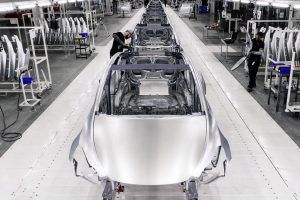- 🌍 All EU member states are expected to support new tariffs on China-made EV imports by November.
- 🏢 The European Commissioner of Trade, Valois Dombrovskis, has announced support from all 27 EU member states for tariffs up to 38% on Chinese EV imports.
- 🚗 The aim is to protect the EU car industry from the rapidly growing Chinese battery electric vehicle market.
- 📆 EU member states will vote on the tariff proposal in late October, with enforcement expected by November if approved.
- 🔢 In July, 11 member states voted in favor, and 10 abstained (considered supportive), meeting the requirement for the tariffs to pass.
- 🇺🇸 The US already has 100% tariffs on Chinese EV imports, and Canada is considering similar measures.
As the global automotive landscape evolves, the European Union is taking decisive steps to protect its car industry from the rapid expansion of Chinese electric vehicles (EVs) in the market. With all 27 EU member states poised to support tariffs on China-made EVs by November, this significant move aligns the EU with the United States, which has already implemented stringent measures. This blog post delves into the implications, motivations, and potential outcomes of this crucial decision.
The Path to New Tariffs
A Unified Decision
The European Commissioner of Trade, Valois Dombrovskis, recently announced that all 27 EU member states are expected to support the new tariffs on China-made electric vehicle imports. These tariffs could reach up to 38%, providing a significant protective measure for the EU’s automotive sector.
The decision comes after a careful consideration of the rapid growth of China’s battery electric vehicle market and the subsidization that has facilitated this expansion. By introducing these tariffs, the EU demonstrates a clear intent to safeguard its car industry from potential injury.
Timeline of Enforcement
The EU member states will vote on the tariff proposal in late October. If the vote is positive, the new tariffs will be enforced by November. This swift timeline underscores the urgency and determination with which the EU is addressing this issue.
Motivations Behind the Tariffs
Protecting the EU Car Industry
One of the primary motivations for imposing these tariffs is the protection of the EU’s car industry. The market share of Chinese battery electric vehicles has been growing rapidly, posing a considerable threat to local manufacturers. By introducing tariffs, the EU aims to level the playing field and ensure that its car industry remains competitive.
Addressing Subsidization Concerns
Chinese electric vehicles have benefited from substantial subsidies, enabling them to compete aggressively in global markets. The EU’s tariffs are a response to these unfair trade practices, seeking to mitigate their impact and promote fair competition within the automotive sector.
A Look at the Broader Context
Comparison with the United States
The United States has already imposed 100% tariffs on Chinese EV imports. This move reflects a broader trend of adopting protectionist measures to shield domestic industries from foreign competition. The EU’s approach, while less severe, aligns with this trend and signals a coordinated effort among Western economies to address the challenges posed by China’s rapid industrial expansion.
Potential Impact on Global Trade
The imposition of tariffs by the EU and potentially by other countries, like Canada, could have significant implications for global trade dynamics. China’s reaction to Canada’s consideration of similar tariffs underscores the sensitivity of these measures. There is a possibility of trade tensions escalating, affecting relationships and economic interactions between these nations.
Anticipated Outcomes
Positive Impacts on the EU Car Industry
If successfully implemented, the tariffs could bolster the EU car industry’s position in the global market. By reducing the competitive edge of subsidized Chinese EVs, European manufacturers may find increased opportunities to innovate and thrive.
Challenges and Considerations
However, it is essential to recognize the potential challenges. The imposition of tariffs could lead to increased costs for consumers and potential retaliatory measures from China. The EU must navigate these complexities carefully to balance protection with the benefits of free trade.
Conclusion
The EU’s decision to impose tariffs on China-made electric vehicle imports marks a significant strategic move in the global automotive landscape. By protecting its car industry and addressing subsidization concerns, the EU aims to create a fairer and more competitive market environment. As the vote approaches in late October, the automotive world will be watching closely to see how these developments unfold and shape the future of the industry.
With the potential to drive innovation and safeguard local manufacturing, this decision underscores the importance of strategic trade policies in an increasingly interconnected global economy.





